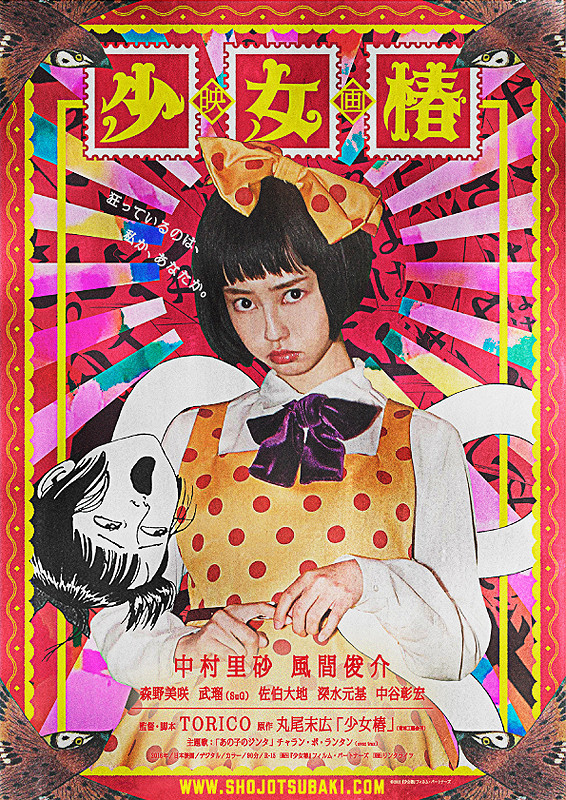 MIDORI: THE CAMELLIA GIRL was the second film adaptation of Suehiro Maruo’s 1984 ero guro manga, published in English as MR. ARASHI’S AMAZING FREAK SHOW but known in its native land as SHÔJO TSUBAKI. That’s also a term for a stock orphan girl character from early Twentieth Century Japanese street theater, which Maruo, who was heavily inspired by the art and culture of 1920s Japan, definitely picked up on.
MIDORI: THE CAMELLIA GIRL was the second film adaptation of Suehiro Maruo’s 1984 ero guro manga, published in English as MR. ARASHI’S AMAZING FREAK SHOW but known in its native land as SHÔJO TSUBAKI. That’s also a term for a stock orphan girl character from early Twentieth Century Japanese street theater, which Maruo, who was heavily inspired by the art and culture of 1920s Japan, definitely picked up on.
…heavily inspired by the art and culture of 1920s Japan…
The first adaptation of this material was 1992’s CHIKA GENTŌ GEIKA: SHÔJO TSUBAKI—or, as it’s known in the English speaking world, MIDORI—an independently made anime mini-feature by Hiroshi Harada that underwent heavy censorship. MIDORI: THE CAMELLIA GIRL (SHÔJO TSUBAKI; 2016), a live action feature adaptation, has to my knowledge not been censored anywhere, but it suffered an even worse fate: near-complete indifference. Directed by the sometime actress and fashion designer Torico, the film stars Risa Nakamura, a fashion model in her first (and thus far only) acting role.
Directed by the sometime actress and fashion designer Torico, the film stars Risa Nakamura, a fashion model in her first (and thus far only) acting role.
She plays Midori, who joins a travelling freak show after the death of her mother. This show is a nightmare, manned by perverts and human oddities of every conceivable stripe—and Midori, despite her repugnance for what she sees, fits in quite well given her unique sense of fashion, which includes a yellow dress with red polka dots and a massive bow in her hair to match.
Things change for her when Wonder Masamitsu, a magician whose hair has been slicked into devil horns, shows up. First seen shut up inside a bottle, from which he extricates himself by shifting his body mass, Masamitsu quickly becomes the freak show’s major draw. He makes Midori his assistant, which gives her an elevated standing in the hierarchy. She’s further assisted by spells cast by Masamitsu, which cause her to grow to a massive size and her tormentors to die via elaborate hallucinations.
…a nightmare, manned by perverts and human oddities of every conceivable stripe…
 But Masamitsu’s attentions grow stifling and abusive. When the audience at one of his magic shows turns on him he causes them to undergo horrific physical mutations, including massive exploding boils and ballooning testicles. Things don’t go much better with Masamitsu’s remaining fellows, who become determined to get rid of him, as does Midori.
But Masamitsu’s attentions grow stifling and abusive. When the audience at one of his magic shows turns on him he causes them to undergo horrific physical mutations, including massive exploding boils and ballooning testicles. Things don’t go much better with Masamitsu’s remaining fellows, who become determined to get rid of him, as does Midori.
All this is done up in a VERY stylized, color-coded manner that plays up the story’s kitschy elements. Animation is utilized to visualize the wilder elements of the source material (such as Midori growing an insanely long snakelike neck and travelling into an enchanted mirror universe), which given the patently unreal nature of the film doesn’t feel out of place.
All this is done up in a VERY stylized, color-coded manner that plays up the story’s kitschy elements.
The storytelling is odd, with much of the action related after-the-fact in the form of recollected thoughts. Those thoughts are visualized, more often than not, via intentionally primitive animation, while the past and present are interwoven in a manner that’s confusing first and foremost (with the death of Midori’s mother, which drives the story, going unrevealed until twenty minutes into it).
Given Torico’s fidelity to Suehiro Maruo’s source, a great deal of not-for-the-squeamish imagery is inevitable (included is a depiction of eyeball-licking, a Maruo trademark). Yet its Maruo’s twisted imagination that gives this otherwise vastly overdone film its effectiveness.
See Also: MIDORI
Vital Statistics
MIDORI: THE CAMELLIA GIRL (SHÔJO TSUBAKI)
Link Lights
Director: Torico
Producers: Tutsi Horikoshi
Screenplay: Torico
(Based on a manga by Suehiro Maruo)
Cinematography: Takeshi Sone
Editing: Hiroki Yamaguchi
Cast: Risa Nakamura, Shunsuke Kazama, Misaki Morino, Motoki Fukami, Daichi Saeki, Takeru, Akihiro Nakatani, Takeru, Macoto Tezuka, Minoru Torihada, Miyuki Toril, Keisuke Urushizaki, Mame Yamada
